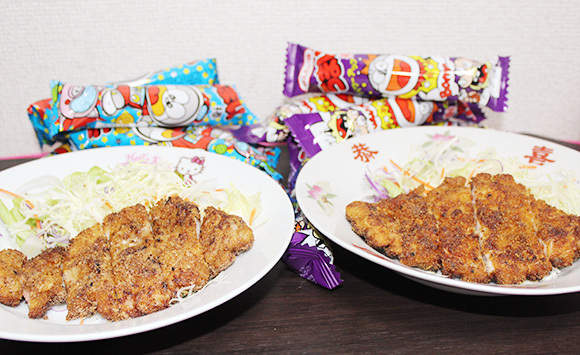
Following the enormous success of our cup noodle gourmet experiment, we decided that it was time to give a couple of other cheap and cheerful snacks an image overhaul by turning them into something a little more glamorous. This time around, we opted for Japanese kids’ favourite Umaibō (lit. “delicious stick”), a 10-yen (10 cents) puffed corn snack that’s available in all manner of flavours. With its dry, powdery exterior and rich taste, we couldn’t help thinking that it might go well with chicken or pork, so we decided to use a few in place of the breadcrumb coating for tonkatsu fried pork fillet.
As it turns out, the result was even more umai than we could have possibly imagined.
Umaibō have been around in Japan since 1979, quickly becoming a staple snack for kids thanks to its low price, strong taste and bright, Doraemon-esque packaging. The consistency of the snack is similar to corn snacks available in the West like Wotsits in the U.K. and Cheetos in the U.S., but thanks to the enormous variety of flavours that Umaibō are available in – from corn potage to pizza and chocolate – there are few people who ever claim to dislike them. There were two varieties in particular, though, that seemed ideal for our experiment.
- Umai breadcrumbs!
Ordinarily, the making of tonkatsu is a simple case of covering a piece of pork fillet in flour before coating it in beaten egg and dipping in breadcrumbs. So it stood to reason that by simply replacing the breadcrumbs with our Umaibō, we were sure to have a hit on our hands. However that would mean turning these little funsticks into a powder…
Settling on tonkatsu sauce and mentai (a fish roe that’s commonly used in Japanese cooking) flavours, we set to work with a grater. To get enough Umaibō powder to sufficiently coat a couple of pork fillets you’ll need four Umaibō per fillet. But at just 10 yen each, we think you’ll agree that this is a pretty reasonably priced cooking ingredient, and when you can pick them up everywhere from supermarkets to convenience stores, they’ll always be in plentiful supply.
▼ Grate, grate, grate.
▼ Scrub, scrub, scrub.
▼ Now we’re getting somewhere!
- Cookin’ it up
With our fillets powdered, dipped and coated in a nice, thick layer of worryingly orange and brown powder, we were ready to fry. After heating up a generous amount of cooking oil in a deep frying pan, we carefully added the meat, remembering to use an “away” motion to avoid hot oil splashing towards us. Within seconds, the room was filled with the sweet smell of roasting Umaibō!
Perhaps because of the number of additives in the corn snacks, it was necessary to keep a close eye on the fillets while they cooked to keep them from burning. Of course, everyone likes a couple of slightly caught edges, but if you’re going to try our alternative gourmet creation out for yourselves, be aware that the coating burns much easier than regular breadcrumbs, so keep a close eye on it.
Before long, though, our fillets were cooked through and, would you believe it, looking really good. We removed the excess oil with some kitchen towels and sliced the crispy fillets crossways, just like the real thing.
▼ First, the Tonkatsu Sauce flavour cutlet.
▼ And the Mentai version.
▼ Not bad! Not bad at all!
- Taste test
Placed on a bed of shredded cabbage, our cutlets looked great. A little overdone in some places, but for a first attempt we were really pleased without ourselves. After giving it a moment to cool, we readied our chopsticks and got ready to take the plunge. Crunchy and sweet, then soft and juicy, the flavours exploded in our mouths. Without a hint or irony, our head chef Megumi threw back her head and let out an ear-piercing shriek of joy, “Umaaaaai!” (“That’s soooo gooooood!”). Another triumph for the RocketNews Kitchen!
Overall, we’d say that the Tonkatsu Sauce flavour Umaibō brought out the flavour of the meat a little better, but for those who really want to keep that Umaibō taste, we’d recommend using the Mentai variety. It may not be fancy, but this is some seriously good eating!
Oh, little Umaibō, we never knew you were so versatile!
▼ Mmmm! Crispy tonkatsu!
▼ Using a thin fillet will reduce cooking time and help prevent the coating from burning.
[ Read in Japanese ]